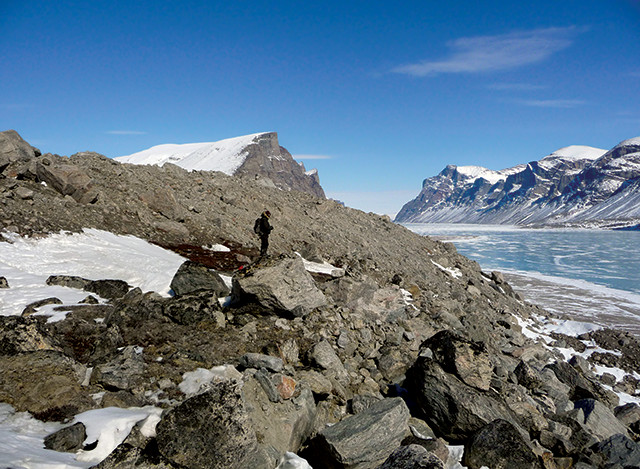
by Mary Caperton Morton Thursday, April 21, 2016

The Vikings first colonized Greenland in A.D. 985 and made a living primarily as dairy farmers for more than 400 years before abandoning the settlements. Credit: Nicolás Young.
Vikings are often depicted as hardy folk and fearsome warriors, but they were not immune to the harsh realities of the northern latitudes. Archaeological evidence suggests that Viking migrations around the North Atlantic were highly influenced by climate, with new settlements being colonized during warm periods and abruptly abandoned during colder times. However, according to a new study of glacial movements in Greenland during the time of Viking occupation, the local climate may have been just as cold when the Vikings arrived as when they left 400 years later. The finding may further shrink the area thought to have been affected by the Medieval Warm Period.
The Vikings migrated from Iceland to Greenland in A.D. 985, with roughly 3,000 people eventually settling in the new land. The timing coincides with the Medieval Warm Period, a time of mild temperatures well documented in Europe between 950 and 1250. Between 1360 and 1460, however, around the time of the Little Ice Age, the Viking colonies in Greenland disappeared, leaving behind few clues as to why they were abandoned.
To study the changing climate in Greenland during the Viking occupation, a team led by Nicolás Young of Columbia University’s Lamont-Doherty Earth Observatory sampled terminal moraines left behind by past glaciers in southwestern Greenland and across Baffin Bay on Baffin Island. Isotopic analyses of the surfaces of boulders in the moraines allowed the team to determine when glaciers had originally transported and deposited the moraines at their current locations. “This method is most often used to trace glaciers several thousand to several tens of thousands of years ago,” Young says. “Our goal was to see if this method could be used on younger glacial deposits.”
Based on this dating, the researchers reported in Science Advances that the glaciers were at their maximum extent from about 925 to 1275. So, while Iceland and Europe may have been warmer during this period, it seems that Greenland remained cold enough to allow glaciers to advance, Young says. “It was cold when [the Vikings] got there and it was cold when they left,” he says, adding that “if they entered Greenland when it was cold, it’s unlikely they were driven out by cold.”
The findings support the idea that the Medieval Warm Period was confined mainly to Europe, Young says. “The Medieval Warm Period is very well documented in Europe, but it wasn’t global. In fact, warming in Europe often coincides with cooler conditions in Greenland as more cold air gets pulled out of the Arctic and funnels through Baffin Bay.” The pattern points to a possible relationship between the Medieval Warm Period and an extended phase of the North Atlantic Oscillation, a usually decadal-scale climate cycle in which warm air flowing from the tropics raises temperatures in Europe and Iceland while Greenland and Baffin Island get colder due to influxes of Arctic air.
However, glacial moraines are not necessarily a reliable source of temperature data for this region, says William Patterson, a geochemist at the University of Saskatchewan in Canada who was not involved in the new study. “The problem … is that when it gets warmer in this part of the North Atlantic, you actually get more ice in some areas, including Greenland,” because there is more evaporation and increased snowfall, he says. The observations of glacial advance in the new study might thus suggest that relatively warm temperatures had extended to Greenland by the time of the Vikings’ arrival.
More reliable climate records for this part of the world are found in the growth rings of the shells of clams, which can live 500 years and preserve temperature records over centuries, Patterson says. Such records have previously shown a period of warming in Greenland beginning about 900, followed by periods of cooler summer temperatures starting about 1100. In Patterson’s estimation, the Vikings arrived in Greenland “when things were good, but shortly after [that], things went bad. The Norse depended on livestock, and when summer temperatures dropped by a couple degrees, that meant less fodder for the animals and often famine.”
Few human remains dating to the time of the Viking abandonment of Greenland have been found, but archaeological evidence points to at least four episodes of extreme hunger while they were there, with people eating dogs and livestock, all the way down to hides and hooves, Patterson says. “They ate everything they could possibly eat, and then they left Greenland” in the early 1400s, he says.
For now, it seems the question of what Greenland’s climate was like during the Vikings’ tenure there remains open to interpretation. Young says he and his colleagues plan to continue their glacial moraine studies elsewhere around the North Atlantic to further test the technique on younger deposits and gauge the extent of the Medieval Warm Period outside of mainland Europe. “The evidence is mounting that the Medieval Warm Period was patchy, not global,” Young says. “The concept is Eurocentric — that’s where the best-known observations were made. Elsewhere, the climate may have been much cooler.”
© 2008-2021. All rights reserved. Any copying, redistribution or retransmission of any of the contents of this service without the expressed written permission of the American Geosciences Institute is expressly prohibited. Click here for all copyright requests.